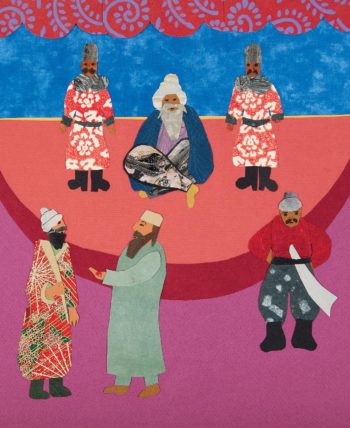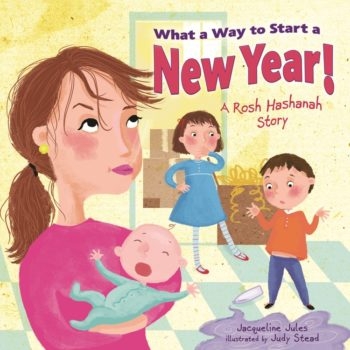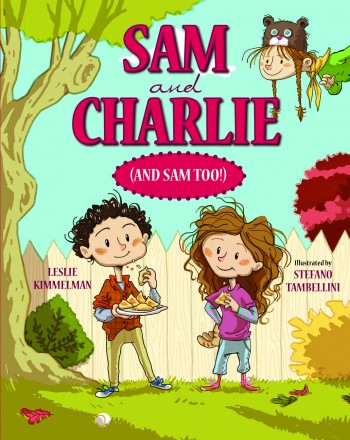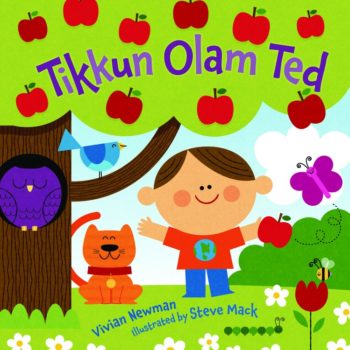For the New Year, children’s books opening new worlds
Published August 19, 2013
BOSTON (JTA) — Shofars, apples and honey, make room for pomegranates, couscous and pumpkins.
The new crop of children’s books for the High Holidays opens a world beyond the beloved traditional symbols of the New Year (Rosh Hashanah begins at sundown on Sept. 4).
From ancient times to today, the savory, engaging reads presented here will take families from the kitchen to the bedroom to the sukkah.
Jewish Fairy Tale Feasts: A Literary Cookbook
Tales Retold by Jane Yolen; recipes by Heidi E.Y. Stemple; illustrated by Sima Elizabeth Shefrin
Crocodile Books/Interlink, $25; ages 5 and older

JTA HOLIDAY PHOTOS: For the New Year, children’s books opening new worlds
An illustration from “Jewish Fairy Tale Feasts: A Literary Cookbook,” which offers recipes along with its collection of Jewish folk tales. (Courtesy Interlink Publishing Group)
Master storyteller Jane Yolen and her daughter, Heidi E.Y. Stemple, a cook and children’s writer, serve up a collection of richly detailed retellings of Jewish folk tales from around the world paired with kid-friendly recipes for Jewish foods. Yolen presents a range of tales, from the entertaining and humorous to lesser-known sophisticated tales for older readers that pose life’s challenges. Stemple offers up tempting recipes adapted for today’s families, from the traditional, familiar Eastern European fare to some lesser-known African and Sephardic cuisine.
The brightly colored collages and recipe illustrations by Sima Elizabeth Shefrin make the book a pleasure to browse for all ages.
Among the 18 stories and recipes are two Rosh Hashanah entries. “Two Jars of Honey,” set in the days of King Solomon, where a wise beyond his years Solomon resolves a feud between neighbors. All ends well on a note of compassion and forgiveness. A recipe for honey cake, a traditional sweet eaten during the High Holidays, includes a surprising ingredient — a can of cola.
In “The Pomegranate Seed,” a tale that originated in Morocco, a poor man caught stealing uses his wit and a moral challenge to save himself. An appealing recipe for pomegranate couscous is packed with flavor, texture and color from pomegranate seeds, dried apricots, cinnamon, cilantro and fresh mint. An added note explains that pomegranates are associated with Rosh Hashanah because the red, globe-shaped fruit is said to have 613 seeds that correspond with the Torah’s 613 mitzvot, or commandments.
It would have been easy to fill a cookbook with Jewish tales about challah and chicken, common Jewish foods, Yolen tells JTA, adding that it took plenty of research to find stories that matched the book’s breadth of recipes.
“When I found the honey cake story, I was thrilled,” Yolen recalls.
Budding storytellers, folklorists and teachers will appreciate Yolen’s outstanding end notes that credit other storytellers for their earlier versions and provide the origins and cultural history of the stories.
In the introduction, Yolen and Stemple write that storytelling and cooking change over time and location.
“Be playful,” they encourage, and “let’s eat!”
What a Way to Start a New Year! A Rosh Hashanah story
Jacqueline Jules, illustrated by Judy Stead
Kar-Ben; $16.95 hardcover, $7.95 paperback; ages 3-8

In “What a Way to Start a New Year!” a family moving into a new neighborhood shares a Rosh Hashanah meal with some new friends. (Courtesy Kar-Ben Publishing)
Award-winning author Jacqueline Jules’ “What a Way to Start a New Year!” is a lighthearted and authentic story for Rosh Hashanah that reflects the diversity of today’s Jewish families and the hustle and bustle of daily life.
In the opening pages, a perky young girl is eating a slice of pizza in her family’s new home, which is filled with unpacked boxes. Her family, including two younger brothers, has just moved to a new town. While her dad isn’t Jewish, he loves celebrating the High Holidays. But how will they observe the New Year, our storyteller wonders with some concern.
When they venture back to their old neighborhood to share a traditional Rosh Hashanah meal with their friends, one plan after another goes awry. “What a way to start a new year!” they each sigh after mishap follows zany mishap.
Things begin to look up when one of dad’s co-workers invites them to synagogue services. While the prayers and songs are familiar, the kids still feel out of place because they don’t recognize anyone.
Finally they are welcomed to share Rosh Hashanah dinner with new friends. “What a wonderful way to start a new year!” the young girl exclaims.
Judy Stead’s brightly colored, cartoon-like illustrations are a lively accompaniment to the story.
An author’s note reminds parents that while starting in a new home or school can be difficult, it’s made easier by generous hosts. She explains the mitzvah of “hachnasat orchim,” “welcoming guests.”
A Watermelon in the Sukkah
Sylvia A. Rouss and Shannan Rouss, illustrated by Ann Iosa
Kar-Ben; $17.95 hardcover, $7.95 paper; ages 3-8
Decorating a Jewish school’s sukkah becomes inventive when a young boy, Michael, wants to hang his favorite fruit, a watermelon, from the roof. All the kids’ usual ideas — think duct tape and string — fall flat. Michael’s creative thinking and teamwork save the day. A brief author’s note explains the holiday.
Iosa’s fall-toned illustrations of gold, green and purple convey the children’s excitement and disappointment with lively action that will entertain young kids.
Sam and Charlie (and Sam Too!)

One of the five stories in “Sam and Charlie (and Sam Too!)” offers a learning experience about the meaning of Yom Kippur, the holiday of forgiveness. (Courtesy Albert Whitman & Company)
Leslie Kimmelman, illustrated by Stefano Tambellini
Albert Whitman, $13.99, also available on Kindle; ages 6 to 8
A delightful chapter book that was published earlier this year, “Sam and Charlie (and Sam Too!)” is a story of friendship of young new neighbors. The book is divided into five stories that tell of the daily ups and downs among two Jewish friends and a younger sibling. The format and Kimmelman’s light and endearing touch evokes the classic “George and Martha” series by James Marshall, or the beloved “Frog and Toad” series by Arnold Lobel.
The last of the set, titled “I’m Sorry Day,” will have the kids giggling along with Sam and Charlie even as it opens up an easy conversation to the tough subject of apologies and forgiveness. Children of all faiths and backgrounds will have fun with these memorable stories and learn about the meaning of Yom Kippur, the holiday of forgiveness.
Tikkun Olam Ted
Vivian Newman, illustrated by Steve Mack
Kar-Ben; $5.95 board book, also available as eBook; ages 1-4

“Tikkun Olam Ted” is engaging for younger children and could be inspiring for older kids. (Courtesy Kar-Ben Publishing)
From Sunday to Friday, a young, small boy named Ted spends his days doing some big things to make the world a kinder, better place. On Shabbat he rests, dreaming of tikkun olam, the repair of the world.
“Tikkun Olam Ted” is a lively toddler book with colorful illustrations that will engage younger kids. Older ones may be inspired by simple, fun ways to help around the house or out in the world.
![]()














